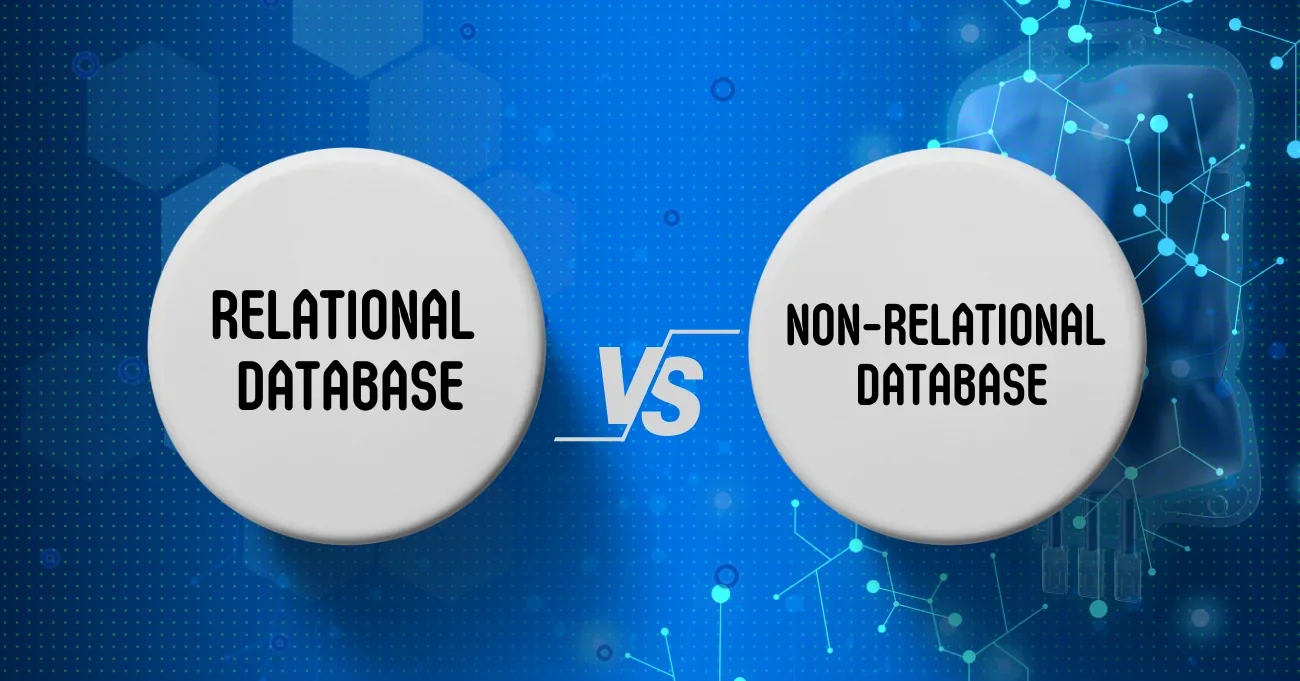The differentiating nuances between a relational database vs non relational database are often overlooked. However, it is essential to understand the core difference between these two concepts since it can be extremely difficult to transition data from one type of database to another once the development process has started. To help save you time and effort, knowing the difference between relational and non relational databases beforehand will help you select the correct type to use.
Aloa, as a software development outsourcing consultancy company, stays updated on the latest developments in the industry. Our experience in working with over 10,000+ pre vetted development professionals and agencies worldwide has given us the insights needed to provide top-tier development services.
Leveraging our experience in the industry, we’ve compiled this blog post outlining the details between a relational database vs non-relational database. We’ll go through their key differences, popular types of databases and how to start building a database. After, you’ll have a complete idea of what each type is and which one to use for your project!
Let's dive right in!
Relational Database vs Non Relational Database: What’s the Difference?
The core difference between a relational database and a non-relational database is how data is structured and organized within each type. Software applications can vary significantly in how they handle data storage, access, and management based on the type used. The choice significantly impacts an application's performance, scalability, and complexity.
Let’s break down each concept:
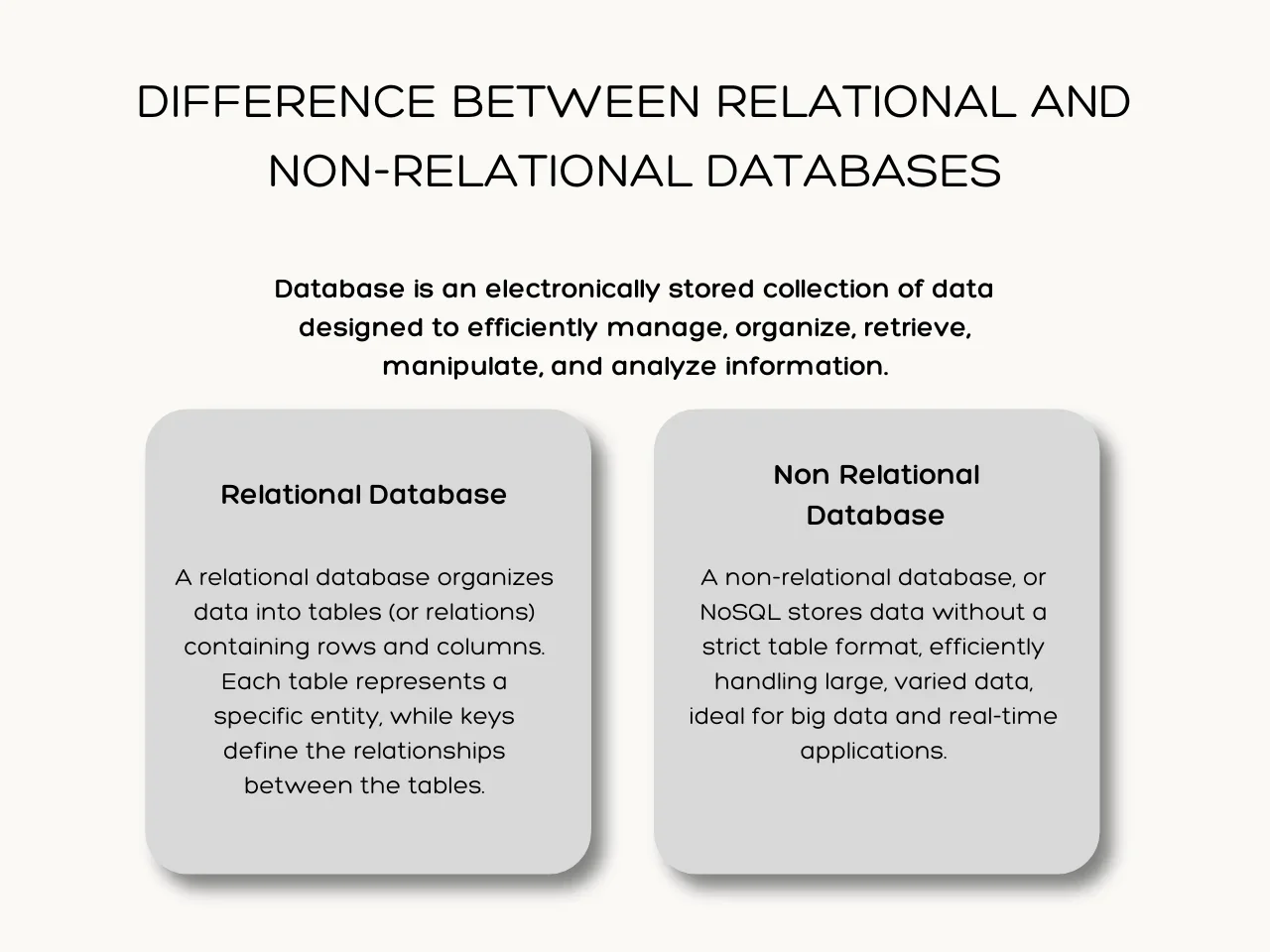
What is a Database?
A database in software development is a structured collection of data stored and accessed electronically. Its design aims to efficiently manage and organize data for users who need to retrieve, manipulate, and analyze information quickly and accurately. A database is the fundamental component of many software applications, acting as the backbone for data storage and retrieval.
What is a Relational Database (SQL)
A relational database or a SQL (structured Query Language) database organizes data into tables (or relations) containing rows and columns. Each table represents a specific entity, while keys define the relationships between the tables. These keys allow for complex querying and data manipulation when necessary.
Let's go through the key components of a relational database:
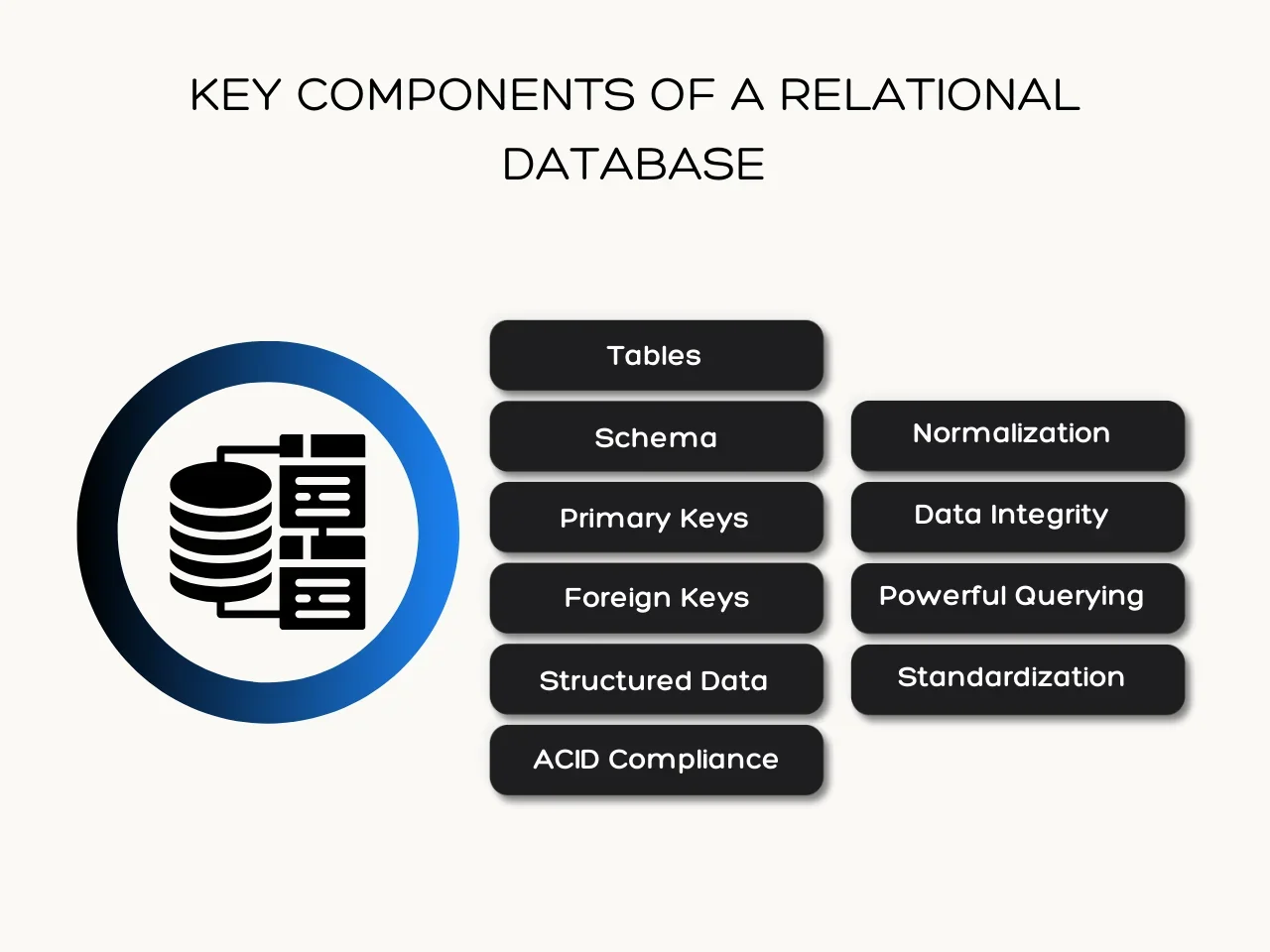
- Tables: The primary structure where data is stored. Each table contains rows and columns, with rows representing records and columns representing fields in a record. Schema: Defines the structure of the database, including tables, columns, data types, and relationships between tables.
- Primary Keys: Unique identifiers for each record in a table, ensuring that each record can be uniquely identified.
- Foreign Keys: Fields that create a link between two tables, establishing relationships between them.
The components of a relational database allow for unique characteristics that enable users to ensure data consistency and integrity throughout the software application. These characteristics are:
- Structured Data: Data is stored in a highly structured format, making it easy to query and manipulate using SQL.
- ACID Compliance: Ensures reliable transactions through Atomicity, Consistency, Isolation, and Durability properties.
- Normalization: Organizing data to minimize redundancy and improve data integrity.
With its structured characteristics, a relational database provides software developers with these main advantages:
- Data Integrity: StroStrong enforcement of data integrity and relationships, reducing the likelihood of data anomalies.
- Powerful Querying: Robust SQL querying capabilities, enabling complex joins, filters, and aggregations.
- Standardization: SQL is widely accepted, ensuring compatibility and interoperability across different systems.
What is a Non-Relational Database (NoSQL)
A non-relational database, or NoSQL (Not Only SQL) database, provides a way to store and retrieve data that does not adhere strictly to the tabular design schema of relational databases. NoSQL databases are better suited for handling large volumes of varied data types and sizes while keeping consistent metrics for high-performance operations, making them ideal for big data and real-time web applications.
Let's go through the key components and types of NoSQL databases:
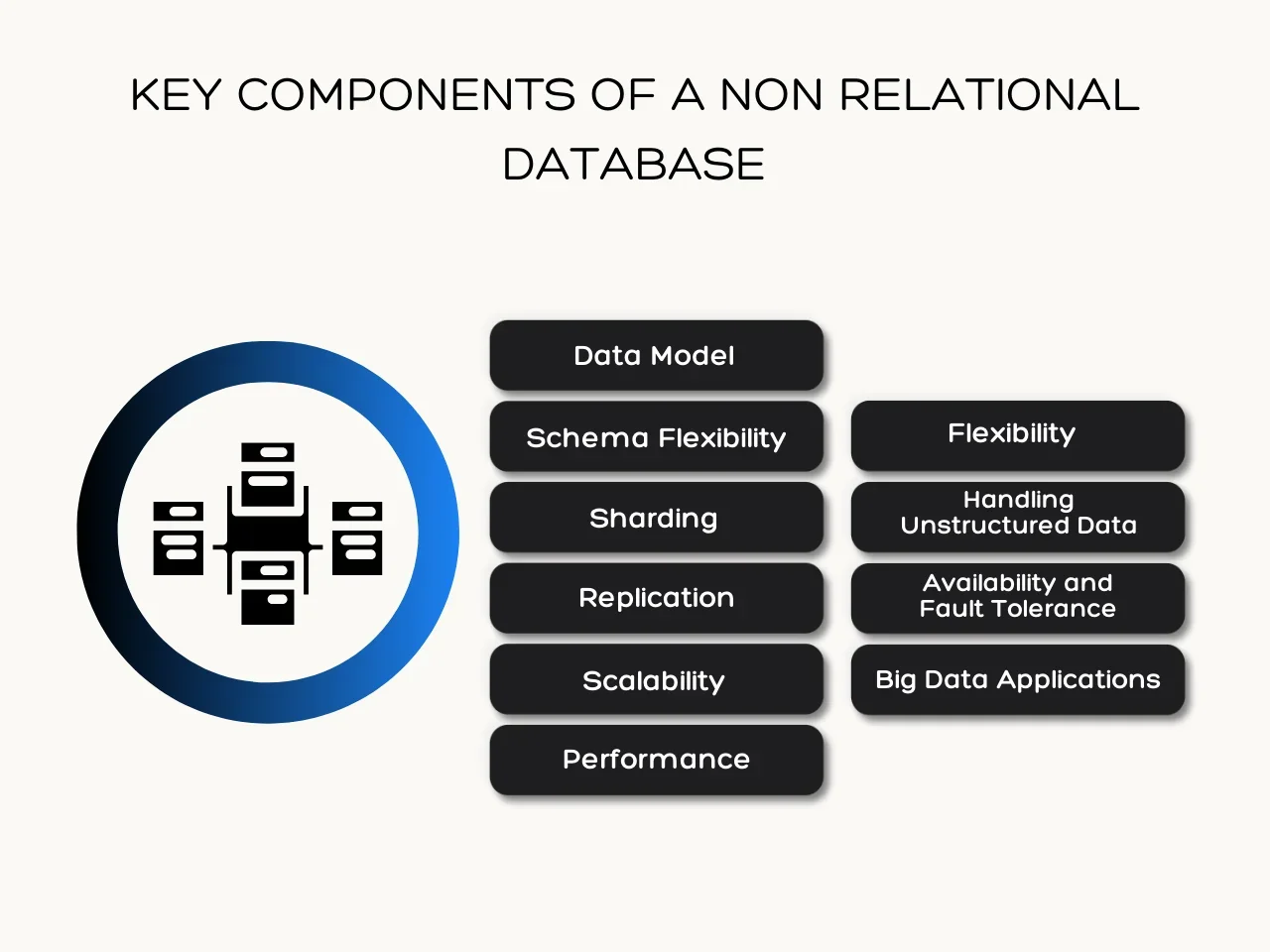
- Data Model: Large variety of data types from document-based, key-value pairs, column-family, or graph-based structures.
- Schema Flexibility: No fixed schema; data models can be dynamically adjusted to fit based on the design and needs of the application.
- Sharding: Data is horizontally partitioned into multiple servers to ensure scalability options remain viable for long-term usage.
- Replication: Real-time web applications that deal with large and repetitive data benefit from NoSQL databases' ability to replicate data across multiple nodes.
Each component offers a more extensive selection of options based on the developer's specifications and application requirements. High-performance operations are more accessible to track and manage under the right database practices. NoSQL platforms heavily rely on these characteristics to stand out:
- Scalability: Horizontal scaling makes distributing this non-relational database through multiple servers easier.
- Performance: High read/write performance suits real-time applications and programs perfectly.
- Flexibility: Schemaless design allows for easy adaptation to changing data requirements.
These characteristics provide various advantages that set it apart from the other types of databases. These benefits are:
- Handling Unstructured Data: Semi-structured and unstructured data storage and manipulation are easier to handle while also opening for complex systems for management.
- Availability and Fault Tolerance: Often designed with built-in replication and distribution features, ensuring high availability.
- Big Data Applications: Suitable for handling large volumes of data generated at high velocity.
5+ Key Differences Between Relational and Non-Relational Databases
With a high-level understanding of relational vs. non-relational databases, you can now compare them against each other when it comes to their key differences. To fully understand these differences, it's important to look at how they differ regarding data structure, performance, scalability, schema, and development.
Let's go through each one individually:
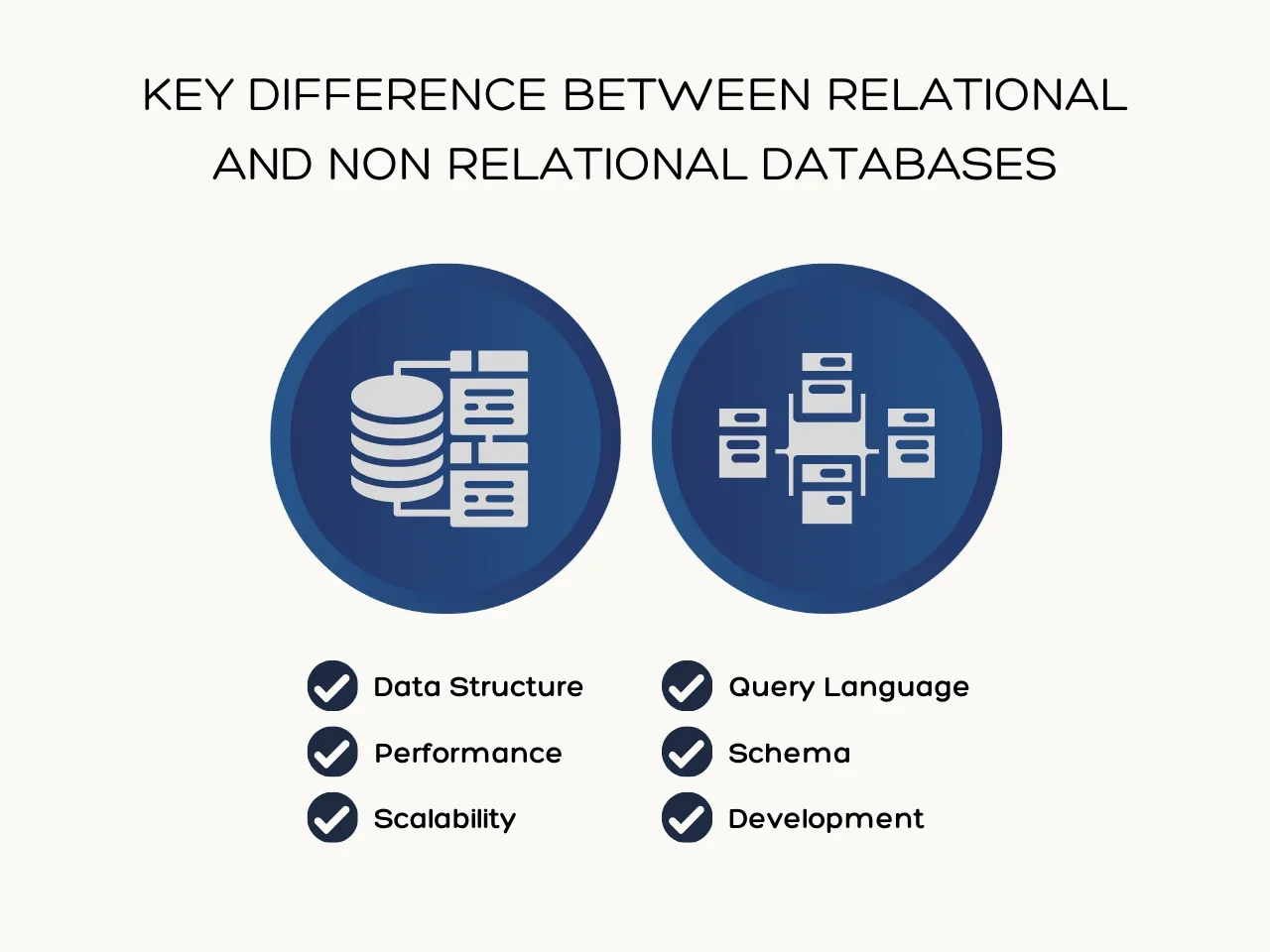
1. Data Structure
A data structure is how data is organized and stored in a database. Relational databases use a table-based structure, while non-relational databases use different data models, such as key-value, document, column families, and graphs.
A relational database is well-suited for any application that demands a high level of data organization, integrity, and relational mapping. On the other hand, software applications that require flexible, scalable solutions to handle large volumes of diverse and rapidly changing data are better suited for non-relational databases.
2. Performance
When it comes to performance between a relational database vs non-relational database, a relational database provides strong data consistency and integrity. A non-relational database performs faster for specific use cases like big data and real-time processing.
3. Scalability
Scalability in terms of relational and non-relational databases refers to the ability of the database to handle increasing amounts of data and user load without compromising performance. It involves the database's capacity to expand its resources and capabilities to accommodate growth.
Relational databases have limited scalability, making them less suitable for large datasets and high read/write loads. Non-relational databases are highly scalable and can more efficiently handle large-scale, distributed data.
4. Query Language
A query language is a specialized language used to communicate with a database to retrieve, manipulate, and manage data. It allows users and applications to interact with the database by specifying queries that describe the data they want to access or manipulate.
Relational databases use SQL for querying and manipulating data. In contrast, non-relational databases typically use query languages or APIs, which can vary between databases.
5. Schema
A schema is a structure or blueprint that defines how data is organized and represented in a database. It defines the tables, fields, relationships, and constraints that ensure data integrity and consistency within the database.
Relational databases have a predefined schema, making them better suited for structured data. Non-relational databases, however, are more flexible and can accommodate various types of data.
6. Development
In terms of development and a relational database vs a non relational database, relational databases require more development effort when creating complex queries or changing the database structure. Non-relational databases are easier to develop and require fewer resources.
Popular Relational Databases (SQL Databases)
Popular relational databases used in software development include open-source and commercial options that cater to various needs, from small-scale applications to large enterprise systems. Here are some of the most widely used relational databases:
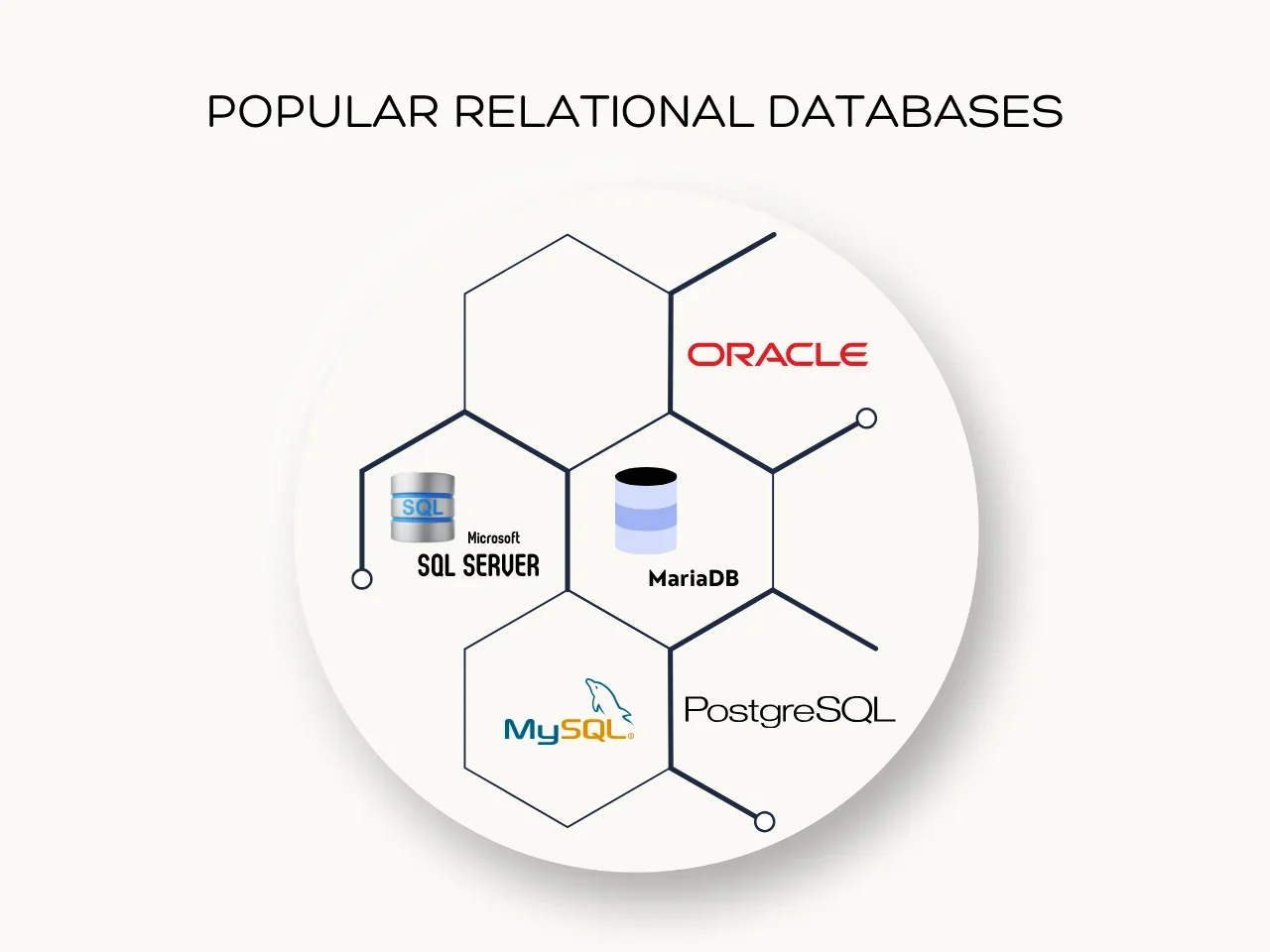
Oracle Relational Database Management System
Oracle Database is a relational database management system that stands out for its scalability. The software's dependability makes it ideal for business applications that require robust and reliable data management solutions. Its scalability capabilities allow Oracle Database to handle large volumes of data and high transaction loads efficiently.
Some other notable features of Oracle’s relational database are:
- Strong Security: Oracle Database offers robust security features to protect sensitive data and ensure compliance with regulatory requirements.
- Consolidate Dashboard: Ideal for keeping track of database performance metrics, resource utilization, and operational health.
- Custom App Development Capabilities: Oracle Database supports custom application development through PL/SQL, Javascript Integration, and Application Express (APEX).
With its wide use in sectors that need top-notch data integrity, like finance, healthcare, and government, Oracle offers a complete package of tools, libraries, and frameworks designed specifically for building applications and managing databases effectively.
Microsoft SQL Server
Microsoft SQL Server is a relational database management system known for its robust performance, scalability, and integration with other Microsoft products. It is a popular choice for businesses of all sizes.
Here are some notable features of Microsoft SQL Server:
- Robust Security Features: Microsoft accompanies its database with crucial security features such as encryption, access control, and compliance tools to protect data.
- High-Performance Scalability: Advanced indexing options, query optimization, and in-memory processing enhance performance.
- Build-in Development and Analytics Tools: Optimize integration with Visual Studio, SQL Server Management Studio (SSMS), and SQL Server Reporting Services (SSRS) for development and data analytics.
Moreover, advanced options like indexing help boost performance, while stored procedures streamline complex operations. Triggers also keep everything running smoothly. All these contribute significantly towards enhancing how applications perform using Microsoft's platform.
PostgreSQL
PostgreSQL is an open-source relational database management system known for its advanced features, extensibility, and standards compliance. This database offers developers opportunities for a free alternative while still being able to handle complex data setups and transactions.
Some notable features of PostgreSQL are:
- Advanced SQL Compliance: Supports various SQL standards and advanced data types.
- Extensibility: Allows users to define custom functions, data types, and operators, making it highly customizable.
- ACID Compliance: Ensures reliable transactions through Atomicity, Consistency, Isolation, and Durability properties.
- MVCC (Multi-Version Concurrency Control): Provides high concurrency and performance by allowing multiple transactions to access the database simultaneously without locking.
PostgreSQL is widely used in various industries, including finance, healthcare, and government, due to its reliability, robustness, and ability to handle complex queries and data models.
MySQL
MySQL is one of the most popular open-source relational database management systems. It is known for its reliability, ease of use, and support for various platforms. Both commercial and community support allow users to receive support from software developers through Oracle to help optimize their data structure.
Some notable features of MySQL are:
- High Performance: Optimized database spread for read-heavy workloads and supports various storage engines to enhance performance.
- Scalability: Supports features such as partitioning, replication, and sharding intended for large-scale applications.
- Flexibility: Out-of-box compatibility with numerous programming languages and development frameworks.
- Community and Commercial Support: Offers a large community of users and developers, along with commercial support options through Oracle.
MySQL is widely used in web development, particularly for applications built on the LAMP stack (Linux, Apache, MySQL, PHP/Perl/Python). This database platform is heavily favored by startups and enterprises alike for its balance of performance and ease of use through community collaboration. To streamline database management and enhance productivity, many developers use a MySQL editor, which provides a user-friendly interface for writing, editing, and optimizing SQL queries.
MariaDB
MariaDB is an open-source relational database management system created as a fork of MySQL. It aims to maintain compatibility with MySQL while providing enhanced features, performance improvements, and additional storage engines, all while running through the same platform coding.
Some notable features of MariaDB are:
- MySQL Compatibility: MariaDB is designed as a drop-in replacement for MySQL, ensuring that applications can switch to MariaDB with minimal changes.
- Enhanced Performance: Optimized for better performance with improvements in query execution, indexing, and storage engine efficiency.
- Additional Storage Engines: Supports a variety of storage engines, including Aria, ColumnStore, and MyRocks, offering more flexibility for different use cases.
- Security Features: Provides advanced security features such as data encryption, user role management, and fine-grained access controls.
MariaDB has gained popularity in the developer community due to its open-source nature, active development, and commitment to maintaining compatibility with MySQL. It is used by organizations of all sizes, from small startups to large enterprises, for a wide range of applications, including web development, data warehousing, and analytics.
Popular Non Relational Databases (No SQL Databases)
Non-relational databases, or NoSQL databases, are designed to handle large volumes of diverse data types and provide high performance and scalability. Here are some of the most widely used NoSQL databases:
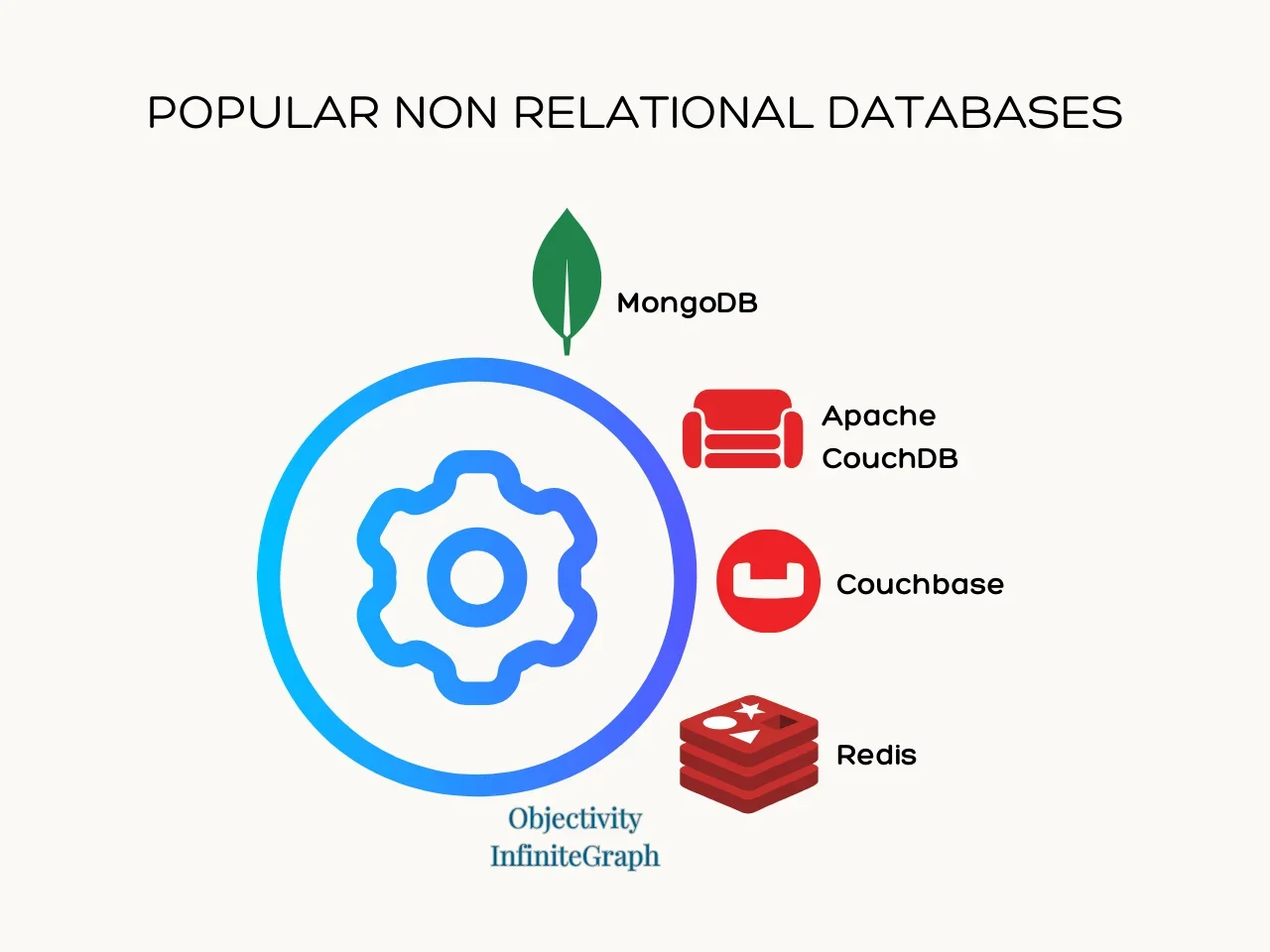
MongoDB
MongoDB is a widely used document-oriented NoSQL database known for its flexibility, scalability, and ease of use. It stores data in JSON-like BSON (Binary JSON) documents, allowing for a flexible schema design.
Some notable features of MongoDB are:
- Document-Oriented Storage: Data is stored in flexible, JSON-like documents, making it easy to model and retrieve complex data structures.
- Scalability: Supports horizontal scaling through sharding and distributing data across multiple servers for high availability and performance.
- Indexing: Provides powerful indexing capabilities, including geospatial and text search indexes, to optimize query performance.
- Aggregation Framework: Offers a robust aggregation framework for data processing and analytics.
MongoDB is commonly used in web development, content management systems, and real-time analytics applications because it handles dynamic and complex data.
Apache CouchDB
Apache CouchDB is a document-oriented NoSQL database with a schema-free JSON format for data storage. It is designed to be highly available, scalable, and easily replicated to manage and store data. Companies that conduct large data collection through web application integration are the best fit for this kind of database.
Some notable features of Apache CouchDB are:
- Multi-Version Concurrency Control (MVCC): Ensures high performance and data consistency by allowing multiple versions of document types.
- Replication: Ensure high availability and fault tolerance through seamless data replication across multiple nodes.
- RESTful HTTP API: This API uses a RESTful API for database interactions, which is intended to simplify the integration process with web applications.
- Eventual Consistency: Designed to provide eventual consistency, ensuring all nodes converge to the same state over time.
Apache CouchDB is a good candidate for applications that require distributed data storage, offline-first capabilities, and high availability, such as mobile apps and web applications.
Couchbase
Couchbase is a distributed NoSQL database that combines the capabilities of a document store and a key-value store. The data structure is heavily optimized to work best with real-time applications for its scalability and extensive support.
Some notable features of Couchbase are:
- Hybrid Data Model: Flexible handling of large amounts of data through document and key-value data models.
- Optimized Performance: Optimized for low latency and high throughput with features like memory-first architecture and advanced indexing.
- Full-Text Search: Couchbase offers integrated full-text search capabilities, enabling powerful text-based queries.
- Mobile Synchronization: Provides Couchbase Mobile for offline data access and synchronization through the Couchbase Server.
Couchbase is popularized for its investment and scaling capabilities for real-time applications, including gaming, e-commerce, and IoT solutions, as well as its optimized performance and scalability.
Redis
Redis is an in-memory key-value store known for its exceptional speed and versatility. It supports a wide range of different data structures, including hashes, lists, and sorted sets, through complex data entries and relationship management.
Some notable features of Redis are:
- In-Memory Storage: Stores data in memory for higher performance and swift read and write operations.
- Data Analysis Structures: Supports various data structures, enabling efficient handling of different data types.
- Data Mining Persistence: Offers options for data persistence, including snapshotting and append-only file (AOF) logging.
- Pub/Sub Messaging: Provides dedicated publish/subscribe messaging capabilities for real-time application communication.
Through their versatility and speed, Redis' in-memory key-value data stores are a prime option for caching, session management, real-time analytics, and complex messaging systems.
Objectivity InfiniteGraph
Objectivity InfiniteGraph is a distributed graph database for managing and analyzing complex, interconnected data. It is particularly well-suited for applications that require deep relationship analysis.
Some notable features of Objectivity InfiniteGraph are:
- Graph Data Model: Stores data as nodes, edges, and properties, enabling efficient representation of complex relationships.
- Scalability: Supports horizontal scaling, allowing for the distribution of graph data across multiple nodes.
- High Performance: Optimized for fast graph traversals and real-time relationship analysis.
- Advanced Querying: Provides powerful querying capabilities for exploring and analyzing graph data.
Objectivity InfiniteGraph is best used in applications such as fraud detection, social network analysis, and recommendation engines, where understanding and analyzing relationships is critical.
How to Start Building a Database for Software Applications
Building a software application requires that developers apply the use of the correct type of database to store, manage, and retrieve data efficiently. Selecting the right database type—relational or non-relational—based on the application’s requirements can significantly impact its performance, scalability, and overall success.
Here is a step-by-step guide on how to build a database to use for software applications.
Step 1: Understand the Use Cases for Relational and Non-relational Databases
The first step to go through when building a database for a software application is to thoroughly understand the various use cases when it comes to a relational database vs a non relational database. Let's go through a few common use cases for each type of database:
When to use relational databases:
- Transactional Systems: Applications that require reliable transactions, such as banking systems and online stores.
- Reporting and Analytics: Scenarios, such as business intelligence tools, require complex querying and reporting.
- Customer Relationship Management (CRM): Systems that manage customer data and interactions.
- Enterprise Resource Planning (ERP): Systems integrating core business processes like inventory management, order processing, and accounting.
When to Use Non-Relational Databases:
- Big Data Applications: Systems that handle large volumes of data generated at high velocity, such as social media platforms.
- Real-Time Web Applications: Applications that require quick read/write operations and low latency, such as gaming or chat applications.
- Content Management Systems (CMS): Systems that store and manage large amounts of unstructured data, such as blogs and news sites.
- Internet of Things (IoT) Applications: Systems that need to store and process data from a wide range of connected devices.
Step 2: Choose a Database Platform
Choosing the database platform requires careful planning and consideration due to the time and effort involved in formulating a project. Each platform can offer various features and components that provide varying degrees of flexibility and quality in project management and production. If you need help, you can pay experts for coding help related to database.
Consider these factors to help choosing a database platform:
- Scalability: Consider the database's ability to handle growth in large quantities of data volume and user load.
- Performance: Check the minimum speed requirements that each database needs to meet for optimal data access and manipulation.
- Flexibility: Changing data requirements and adding or removing different quotas can help gauge the flexibility of the database.
- Cost: Pricing plans can widely differ from one database platform to another. Managing costs while calculating additional expenses can help make the decision easier to manage.
- Ecosystem: Tech development and data collection require top-notch security and reliable service uptime. Always invest in a database that integrates well with existing tech stack and development tools. Site reliability engineering plays a key role in ensuring these systems remain resilient and consistently available.
Step 3: Design Database Schema and Develop the Database Logic
Choosing a platform provides no benefits without the right database schema and logic strategy to make it run optimally. Identify the main entities, whether tables or collections and their relationships with the database. Defining the entities helps normalize or denormalize data depending on whether the platform is relational or not.
Implementing stored procedures and triggers for complex operations and data integrity can help index all information and speed up the data retrieval process.
Step 4: Test Out the Database
Thoroughly test the database to ensure that it meets the demanding specifications required for each project. Functional testing will help verify that operations such as CRUD, transactions, and queries work as intended while also determining whether the performance metrics remain consistent under heavy stress loads.
Backup safety measures should also be experimented with to prevent data loss while opening up functions for cloud recovery. Any vulnerabilities within the database should be addressed before officially launching the platform.
Step 5: Deploy and Monitor the Database
Once all the metrics and fine-tuning have been calibrated, deploying the database to the production environment is the final step to ensure that everything runs smoothly. Deployment automation tools help ensure a smooth transition to production. Ensure that a reliable monitoring tool is used to keep track of any security events and error logs that arise.
Planning ahead to keep data logs of various components that can be used for maintenance and scaling. Shifting strategies with development can be easier to manage with the appropriate usage of these databases.
Key Takeaway
Untangling the difference between a relational database vs non relational database is an essential first step to take when building successful software applications. Both types carry its own strengths and weaknesses while also providing unique properties that cater to different application needs.
Software development teams do well to thoroughly understand the capabilities of each type before choosing which to apply to a project. In doing so they can ensure that the chosen database aligns with the project’s specific needs and goals, optimizing performance, scalability, and data management.
Looking to work with skilled professionals adept in relational and non relational databases for your software application project? Reach out to us at [email protected] where our Account Executives can walk you through our development process and link you up with skilled developers in the industry!

